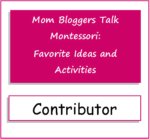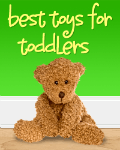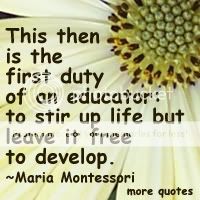Valjci za umetanje služe za upoznavanje s različitim dimenzijama. Pribor se sastoji od četiri drvena bloka koji imaju po deset valjaka različitih dimenzija:
The cylinder blocks are used for learning and exploring various dimensions. Material consist 4 wooden blocks, which have 10 cylinders in different sizes:
The cylinder blocks are used for learning and exploring various dimensions. Material consist 4 wooden blocks, which have 10 cylinders in different sizes:
Blok A Block A
Valjci se razlikuju samo u jednoj dimenziji: visini.
Cylinders differ only in one dimension: height.
Cylinders differ only in one dimension: height.
Blok B Block B
Valjci se razlikuju u dvije dimenzije: širini i dužini (promjer).
Cylinders are different in two dimensions: width and length (diameter).
Blok C Block C
Valjci se razlikuju u tri dimenzije: širini, visini i dužini.
Cylinders are different in three dimensions: width, height and length.
Blok D Block D
Valjci se razlikuju u tri dimenzije: širini, visini i dužini.
Cylinders are different in three dimensions: width, height and length.
Razlika između blokova C i D je u tome što blok C započinje s visokim valjkom, a blok D s niskim valjkom.
Valjci za umetanje su dobra priprema za pisanje zbog pincetnog hvata kojim dijete hvata držak valjka, zbog rada slijeva na desno... Dijete samostalno u ovom priboru može kontrolirati ispravnost rada jer je pribor konstruiran tako da je u njemu sadržana kontrola pogreške.
Način rada se može pokazivati djeci od starije jasličke dobi (2,5 godine na dalje), tako da je to jedan od prvih pribora koji se pokazuju djetetu koje kreće u Montessori grupu.
The difference between blocks C and D is that block C begins with a high cylinder, and block D with a low cylinder.
The cylinder blocks are good preparation for writing (pincet grisp, work from left to right...). A child can control the correctness of her work because the control of error is contained in material.
You can show the work procedure 2,5 year olds on, so this is one of the first materials that you can show to a child when she comes in the Montessori classroom.
Djetetu prvu prezentaciju pokazujemo s blokom C (valjci se razlikuju u tri dimenzije, sličan je ružičastom tornju i smeđim stepenicama), a ako ga nemamo, počinjemo s blokom B. Kad dijete nauči raditi s jednim blokom, možemo ga upoznati sa slijedećim.
Način rada sa svim blokovima valjaka u boji je isti. Ovdje ću pokazati postupak na bloku A (djeci je najteži jer odozgo svi utori za valjke izgledaju isto).
First presentation is with a block C (cylinders are different in three dimensions, it's similar like the pink tower and brown stairs), and if you don't have block C, begin with a block B. When a child learns to work with one block, you can introduce the next one.
Presentation is the same with all cylinder blocks. Here, I'll show presentation with block A (most difficult for children - from above all the holes look the same).
Blokove nosimo kao na slici - to je najstabilniji i najsigurniji način (bitan je palac ispred radi stabilnosti, valjci su maloj djeci teški). Dobro se vidi da u bloku postoji malo udubljenje za dlanove:
We carry the blocks as shown - this is the most stable and safest way (the thumb in front is essential for stability, the blocks are heavy for young children). You can see clearly that there is a small recess in block, for holding:
Valjke vadimo pincetnim hvatom i stavljamo ih ispred bloka za valjke. Uvijek vadimo od najvećeg/najdebljeg prema najmanjem/najtanjem valjku.
We are pulling the cylinders out with pincet grisp and put them in front of the block. Always pull out from the biggest/thickest to the smallest/thinnest cylinder.
We are pulling the cylinders out with pincet grisp and put them in front of the block. Always pull out from the biggest/thickest to the smallest/thinnest cylinder.
Kad smo izvadili sve valjke, uspoređujemo prvi i zadnji (dijete radi komparaciju). To možemo napraviti i na početku vađenja valjaka iz bloka - tako da prvo izvadimo najveći/najdeblji, zatim najmanji/najtanji, a tek nakon usporedbe, vadimo ostale valjke. Bitno je da uvijek radimo na isti način.
When we pulled out all the cylinders, we are comparing the first and the last. This can be done at the beginning of pulling the cylinders out from the block (first take the biggest/thickest cylinder and then the smallest/thinnest cylinder, and after comparison, you can pull out other cylinders). It is important to always work the same way.

Valjke vraćamo u blok tako da prvo pincetnim hvatom podignemo najveći valjak i s kažiprstom i srednjakom prelazimo po valjku, zatim po donjem bridu valjka, a nakon toga po utoru za valjak i po njegovom rubu. Uvijek prstima klizimo u smjeru kazaljke na satu.
Na isti način vraćamo sve valjke u blok. Ako radite tako da vadite najprije prvi pa zadnji valjak, tako biste ih trebali i vratiti nazad u blok.
We put cylinders back to the block: lift the highest cylinder with pincet grisp and cross along the cylinder with index finger and middle finger, then along the bottom edge of the cylinder, then along the hole fore cylinder and the edge of the hole. Always sliding in a clockwise direction.
We return all the cylinders back in the block in the same way. If you first pulled out the first and then the last cylinder, then you should return to the block in the same order.
We put cylinders back to the block: lift the highest cylinder with pincet grisp and cross along the cylinder with index finger and middle finger, then along the bottom edge of the cylinder, then along the hole fore cylinder and the edge of the hole. Always sliding in a clockwise direction.
We return all the cylinders back in the block in the same way. If you first pulled out the first and then the last cylinder, then you should return to the block in the same order.
Djeci su vrlo zanimljive dodatne vježbe koje radimo nakon usvojenog osnovnog načina rada sa sva četiri bloka:
Children are very interested in additional exercises thatwe're doing when they learn the basic way of working with all four blocks:
Children are very interested in additional exercises thatwe're doing when they learn the basic way of working with all four blocks:
- kombinacija dva, tri ili četiri bloka istovremeno (combination of 2, 3 or 4 blocks at a time):
Na početku (da djeci bude lakše) valjke možete stavljati uz blok kojem pripadaju. Vrlo brzo prelazimo na težu varijantu, kad su valjci pomiješani (sljedeća slika).
At the beginning (that is easier for children), you can put cylinders close to the block they belong. We move very quickly to more severe variant - mixed cylinders (next photo).
At the beginning (that is easier for children), you can put cylinders close to the block they belong. We move very quickly to more severe variant - mixed cylinders (next photo).
- Najnovija dodatna vježba koju sam pokazala djeci je kombinacija valjaka za umetanje i valjaka u boji. Valjci u boji po dimenzijama odgovaraju valjcima za umetanje (razlika je u tome što su valjci za umetanje u boji drveta i imaju držač). Plavi valjci u boji odgovaraju bloku A, crveni bloku B, žuti bloku C i zeleni bloku D: The latest extension that I showed the children is a combination of the block cylinders and the knobless cylinders. Dimensions of knobless cylinders suit to the cylinder blocks (the only difference is that the cylinders for blocks are in natural wood color and have knobs). Blue knobless cylinders match with block A, red with block B, yellow with block C and green knobless cylinders match with block D:
U slučaju da vam valjak u boji ostane u utoru (budući da nema držač), korisna će biti informacija da svaki blok valjaka za umetanje ispod svakog utora ima rupu. Štapićem za ražnjiće (ili nečim sličnim) ćete brzo riješiti problem.
If your knobless cylinder stays in hole (since there is no knob), you could find useful information that there is a hole in each block beneath the cylinder. You can quickly solve the problem with a skewer (or something similar).
Pogled na donju stranu bloka (jasno se vide rupice) / The bottom of the block (clearly visible holes):
Moram priznati da me oblio hladan znoj kad sam prvi put isprobavala ovu vježbu jer mi je jedan valjak u boji ostao u utoru i, unatoč svom lupkanju s donje strane i naginjanju, nije izlazio van. Vrlo brzo sam uočila rupice koje do tad nisam niti primjećivala, pa sam štapićem za ražnjiće odozdo pogurala nestašni valjak van.If your knobless cylinder stays in hole (since there is no knob), you could find useful information that there is a hole in each block beneath the cylinder. You can quickly solve the problem with a skewer (or something similar).
Pogled na donju stranu bloka (jasno se vide rupice) / The bottom of the block (clearly visible holes):
- rad s povezom na očima / working blindfolded
- ocrtavanje olovkom ili bojicom, izrezivanje, ljepljenje.../ sketching with pencil or colored pencil (like metal insets), cutting, gluing...
- rad na daljinu - valjci su na jednom stolu, a blok na drugom. Dijete treba opipati utor u bloku i donijeti valjak koji odgovara tom utoru (starija djeca na taj način mogu raditi kombinaciju nekoliko blokova valjaka) / work on tables - cylinders are on one table and block for cylinders is on another table. The child should cross along the hole in the block, and bring a cylinder that matches a hole from another table (the older children can work the same way with 2, 3 or 4 blocks)
- traženje istih/sličnih predmeta u sobi ili prirodi (npr. stablo, panj...) / searching the same/similar objects in the room or in nature (eg. tree, tree stump...)




























































Great Post! When I first was getting familiar with the cylinder blocks,I made mistake I allowed a child to explore the cylinder blocks. The mistake was I didn't know there was a hole in the bottom to remove a stuck cylinder,now one block is damaged. Your blog rocks!!
OdgovoriIzbrišiThanks for the reminder about the extensions. I must present a few on monday!
OdgovoriIzbrišiDiscovering Montessori, thanks :-)
OdgovoriIzbrišiAnnicles, I'm glad my activities inspired you! Thanks for leaving nice & kind comments :-)
Thanks for the detailed information. I will be saving this for when I will presenting these lessons to Connor.
OdgovoriIzbrišiThanks Basia :-)
OdgovoriIzbrišiI'm glad I've helped.
Great overview of the knobbed cylinders! Thank you...
OdgovoriIzbrišiHi!
OdgovoriIzbrišiI have been having trouble getting to your new post, pink tower/brown stairs.
Hi Discovering Montessori!
OdgovoriIzbrišiI'm writing it now. I hope it will be published tomorrow.
Thanks for visiting :-)
What a great post! We LOVE the cylinder blocks. :)
OdgovoriIzbrišiThanks Mari-Ann :-)
OdgovoriIzbrišiWhat a great post! I had forgotten that you could put the knobless cylinders into the knobbed blocks; I'll draw Short Pants' attention to that later this week. Glad you also posted the tip about the holes in the bottom. :) Thanks for linking up to Montessori Monday!
OdgovoriIzbrišiHi there,
OdgovoriIzbrišiNice to see these presentations
and some nice new ideas!
Can you tell me if anyone
sells enough small cubes and
rods (unfinished) to build
the whole stairs and tower?
I also have an idea to buy
an unfinished tower and paint
the blocks according to the
colors of the bead stairs...
it would lead nicely into the
bead cabinet and squaring
and cubing materials.
Thanks,
Kathryn
Nicole, I'm glad I've inspired you; thanks!
OdgovoriIzbrišiKathy, I don't know who sells something like that, I ordered this material from Nienhuis, but there isn't enough cubes for building a tower or quadrants for building whole brown stairs.
Odličan i edukativan blog, svaka čast na pisanju, savjetima...
OdgovoriIzbrišiOdmah sam se prijavila kao tvoj novi sljedbenik u nastojanju da i dalje pratim tvoje savjete i primjenim ih u radu sa mojom trogodišnjom djevojčicom:)
Navrati do mog bloga možda i ti nađeš nešto za sebe:)
Lijep pozdrav
Zondra Art
Zondra Art, dobrodošla na blog Leptir i hvala na prekrasnom komplimentu :-)
OdgovoriIzbrišiNadam se da će tvoja djevojčica uživati u aktivnostima koje sam opisala.
I ja sam postala sljedbenik tvog bloga :-)